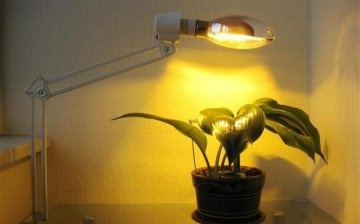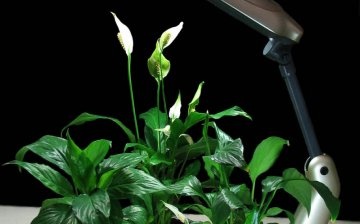Artificial lighting for plants: types of lamps and their installation
In winter, the home garden needs sunshine more than ever. Daylight hours are becoming much shorter, plants do not have enough solar energy. They begin to wither, turn yellow, there is no question of flowering in winter. But the situation is fixable thanks to artificial lighting. Florists resort to lighting - the only solution to the problem. So, in winter you can achieve and flowering, and the rapid growth of domestic plants, and even the fruiting of some crops.
Content:
- What plants need lighting
- What kind of light do plants need
- Types of lighting fixtures
- How to install the backlight correctly
What plants need lighting
All plants can be divided into categories - shade-tolerant and light-loving. The first group can do without illumination. Shade-tolerant crops even differ in appearance. They have dark green foliage, thick, fleshy stems, and tend to have large leaves. If this type of flowers prevails in the apartment, you do not need to think about additional lighting. Usually shade-tolerant green pets rest in winter and do not need bright or diffused lighting. Shade-tolerant crops include:
Saxifrage
Aspidistra
Light-loving cultures are another matter. They do not develop well without sufficient lighting. Some species, more often tropical ones, need bright sunlight. To some - absent-minded. Winter for such plants is a real disaster. If there is not enough light, you can forget about flowering and juicy greenery. Therefore, the florist needs to install additional lighting. Light-loving plants include:
Gasteria
These are just the most common indoor plants that love bright light. When buying a particular flower, always ask about its needs in light. This is very important, otherwise the plant may die with a lack or excess of light. Do not forget that only thanks to sunlight, the plant can, in principle, live and develop.
In fact, even shade-tolerant crops need diffused light. In winter, it will never be superfluous. The main thing is to choose the right phytolamp and install it in the right place.
What kind of light do plants need
The answer to this question, it would seem, is unambiguous - solar. But it is not so. The plant world perceives sunlight in a completely different way, not like a person does.
For normal development and growth, flowers need a red, orange, blue and violet spectrum.
As you can see, not all colors from the sun's rays are perceived by plants. Therefore, the illumination will emit exactly these spectra required by the plants.
Thanks to the red and orange light, the process of photosynthesis starts, without which the existence of a plant is impossible. Blue and violet spectra are necessary for growth, its regulation. Experienced growers know that red, orange light is needed to germinate seeds and develop young sprouts. For already formed plants - mixed or blue, violet light.Having figured out what kind of light plants need, you can choose a lamp.
Types of lighting devices
Garden centers or specialty lighting stores offer a wide range of plant lamps. An inexperienced grower may be confused by such a choice. First of all, it should be learned once and for all that Ilyich's ordinary light bulb is not suitable for illuminating plants. You need to choose either fluorescent, gas-discharge, or LED lamps:
- Fluorescent lamps. This type of lamp is perhaps the most common among florists. Fluorescent lamps are inexpensive and provide the necessary light for plants. They serve for quite a long time, they are conveniently placed over the home garden. Certain types of crops, for example Saintpauliabloom under these lamps in winter. The emitted spectrum is red and blue. If you want to opt for these lamps, keep in mind that they will not work for tall plants (more than 1 meter). They won't be enough. The best-selling types of fluorescent lamps for plants are Osram, Fluora.
- Discharge lamps. In this category of lamps, there are three groups - mercury, metal halide and sodium lamps. The best of these are metal halide backlights. They emit all the spectra of sunlight necessary for plants. Sodium lamps are more suitable for germination young sprouts, as they emit red and orange light. Mercury lamps are not recommended for installation. In general, it is more expedient to install gas discharge lamps in large rooms - greenhouses, greenhouses or large conservatories. For home use, it is better to choose a fluorescent lamp.
- LED bulbs. LED lamps are the latest development in the lighting world. These lamps are perfect from every angle. They are super economical, emit the full spectrum of light that plants need, and are powerful enough. These lamps have one drawback - high cost. Although, purchasing a set of such lamps, you can no longer worry about replacing them in the future. Lamps last so long that the savings from such a purchase will be quite tangible.
- Reflectors and reflectors. Together with the main lighting, it is customary to install reflectors. So, the emitted light is not scattered, it is reflected from the reflector and spreads to the plants. Reflectors do not need to be purchased. They can be replaced by white, matte Whatman paper or food foil, its matte side. Often, growers install such reflectors on windowsills, as a result, sunlight is not scattered, plants receive much more light than without a reflector.
If you decide to install a fluorescent lamp, you will also need a reflector. The flower grower will achieve an even distribution of light in his home garden.
How to install the backlight correctly
It is very important not only to choose the correct lamp, but also to install it correctly. Many novice growers make the same mistake - they hang the lamps too high. Most often, lamps need to be suspended at a distance of 25-30 cm from the uppermost leaves. For shade-tolerant plants, the lamps are placed at a distance of 40 cm. The lamp should be located strictly above the plant, and not from the side or bottom.
In addition to the lamps, install reflectors on opposite sides of the flowerpots so that the height of the reflector fully matches the height of the plants and is slightly higher than them.
If the plant is on a windowsill, place reflectors on all sides, including the space on the side of the room. Mirrors cannot be installed as reflectors, since they do not reflect, but absorb light. Therefore, there will be no sense from them.
Try to follow these simple rules and there will be enough light for the plants. The backlight time is also considered important. You cannot turn on the lamps and leave them for a day. Design the mode according to your color needs.Turn on the lamp 2 hours before dawn, then you can turn it on when dusk falls. In total, flowers need 10-12 hours of daylight. Add to the main, natural daylight hours that number of hours, which together would be the number 12. Usually it is two hours before dawn and two or three after sunset. Thus, the lamp will work for a maximum of 5 hours per day during the winter.
More information can be found in the video:
Tips for flower growers:
- When installing the lamp, always keep in mind that as the plant grows, you will have to raise the lighting fixture higher. Install lamps on special holders, the height of which can be adjusted.
- Already from experience, growers can determine the approximate number of lamps per plant, depending on its type. So, for citrus fruits, philodendrons and monster one fluorescent lamp with a size of 60 cm + installation of reflectors will be enough. For tall plants, more than one meter in height, you need two fluorescent lamps, more than 1 meter in size + reflectors.
- Do not forget that the distance between the plant and lamps for tall crops is at least 40 cm. The distance between the lamps themselves is at least 30 cm.
- If you have a large greenhouse, install different types of lamps. This will ensure that the plants receive the desired spectrum of radiation.
- If we are talking about growing vegetables at home, then the arsenal should have sodium lamps and fluorescent ones. The former are needed to illuminate young shoots, the latter for the growth of mature plants.
Easy to install backlight no, the main thing is to take into account all the nuances and follow the advice of experienced florists and vegetable growers. Do not forget about your favorites in winter, give them the most important thing for their life and development - light!
















